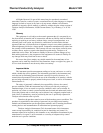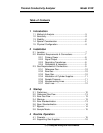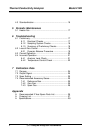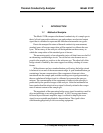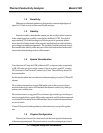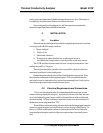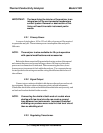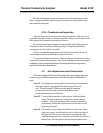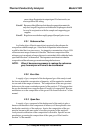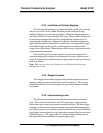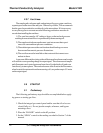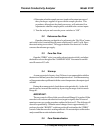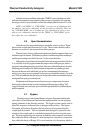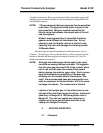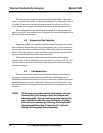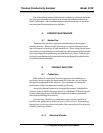
Teledyne Analytical Instruments
10
Thermal Conductivity Analyzer Model 212R
cause a large fluctuation in output signal. For best results, use
electropolished SS tubing
Note #4: Because of the diffusion of air through composition materials,
only dual stage SS regulators with metallic diaphragms should
be used in conjunction with the sample and supporting gas
supplies.
Note #5: Regulators must be thoroughly purged (burped) prior to use.
2.3.1 Reference Gas.
A cylinder of gas of fixed composition is required as the reference for
comparison with the sample gas. A total lack of impurities in the reference
would be ideal but is not necessary. An impurity concentration of up to 50%
of the narrowest range of interest is tolerable. The exact composition of the
reference gas is academic as long as the user is certain that it falls within the limits
specified in Section 7 of the manual. The important consideration is that the
composition of the reference gas remain unchanged when in use.
NOTE: When it becomes necessary to replace the reference
gas, the analyzer will have to be recalibrated.
2.3.2 Zero Gas.
A supply of gas, composed of the background gas of the analysis and
the lowest attainable concentration of impurity, will be required to standard-
ize one end of the ranges of interest. The composition of the zero gas must
be known to the same exactitude expected of the analysis. TAI suggests that
the gas be obtained from a supplier that will certify its composition. Recom-
mendations as to the composition of the gas will be found in Section 7 of the
manual.
2.3.3 Span Gas.
A supply of gas, composed of the background of the analysis plus a
known concentration of the component of interest, will be required to stan-
dardize the sensitivity of the analyzer. Again, the composition of the gas
must be known to the same order of accuracy expected of the analyzer.
Analysis and certification of the composition is desirable. Specific recom-
mendations governing the composition of the span gas will be found in
Section 7 of the manual.



